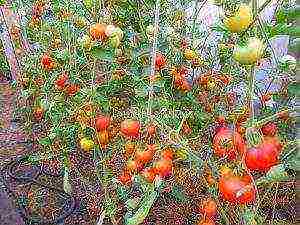Content [show]
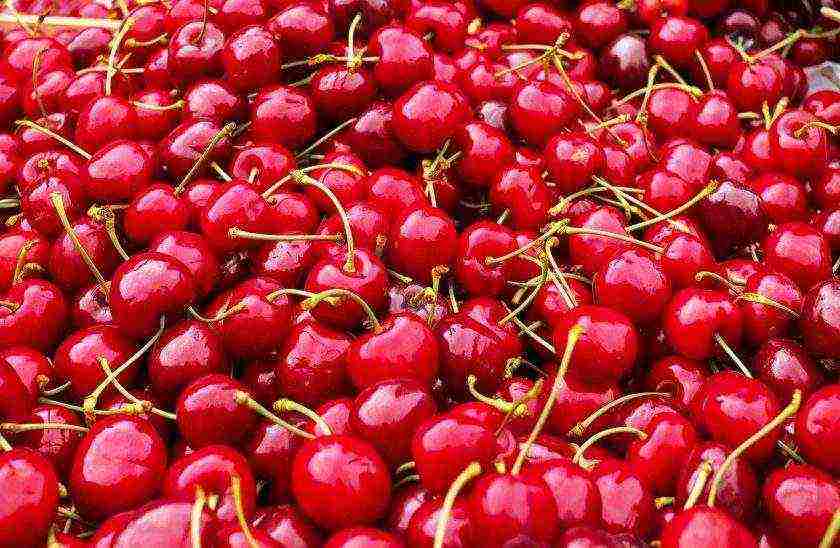
Let's talk about cherries and describe the best varieties of it. There are sweet, slightly sour, crispy, soft, different colors. Thanks to selection, every year new forms of this amazing tree are bred.
Cherry varieties: description and photo
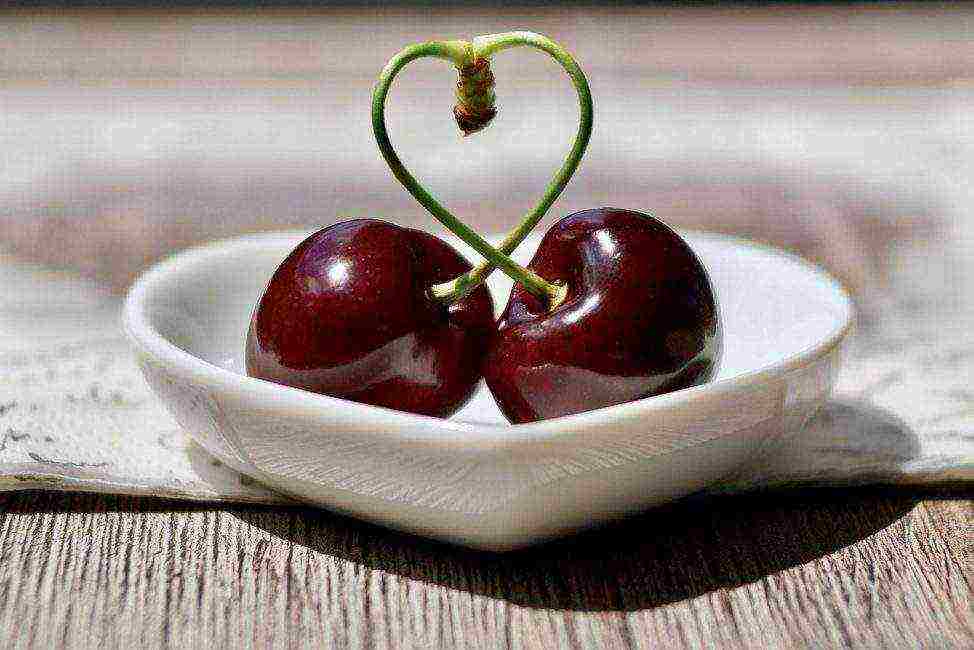
To get a bountiful harvest, it is necessary to choose varieties taking into account the characteristics of the climate in a particular region. So, frost-resistant varieties are suitable for central Russia, and more thermophilic plants can be grown in Ukraine.
Unlike cherry, sweet cherry ripens much earlier, its tasty and aromatic fruits can already be enjoyed in early summer - June. It is a real source of useful trace elements (iron, iodine, potassium, magnesium, calcium) The fruits of the plant grow in the form of a single-celled drupe with a juicy pericarp.
Considering the late period of emergence of cherry fruit buds from the state of forced dormancy, the yield of this crop is characterized as stable. Another advantage of cherries is the presence of reliable protection from return frost in anthers and pistils, which is not the case with cherries.
The leaves of the fruit crop are very large in size, they are distinguished by an elongated-oval or elongated-obovate shape and brown glands on the petioles.
Most of the cherry varieties require additional pollination. Therefore, when choosing a tree, it is recommended to study its description, which indicates the necessary pollinators.
It is not so often possible to find self-fertile varieties on the market. They can be purchased by order from abroad. Among the popular hybrid forms, there are: Alex, Peter, Stella, Sandor, Sweet Hart.
Below is a list of the most popular cherry varieties with descriptions and photos.
Iput

PROS:
- Average height
- Early ripening of fruits
- High yield (up to 30 kg of berries are removed from one tree)
- High palatability (fruits are black in color and dark red juicy pulp)
- The berry is removed with the stalk
- The crop is not afraid of transportation
- High degree of resistance to fungal infections
- It tolerates low temperatures well (up to -28 degrees)
MINUSES:
- Average early maturity (yields a harvest 5 years after planting)
- With an excess of moisture, the fruits crack
- The pulp is difficult to separate from the bone
According to reviews:
It is recommended to plant it in pairs together with Revna, since these varieties are inter-pollinated. It turned out to be very tasty, large, the first harvest is already 3 years old. It grows quickly, almost one-meter increments per year. turned out to be not dark red, but just red, maybe because of the lack of the sun.
Valery Chkalov
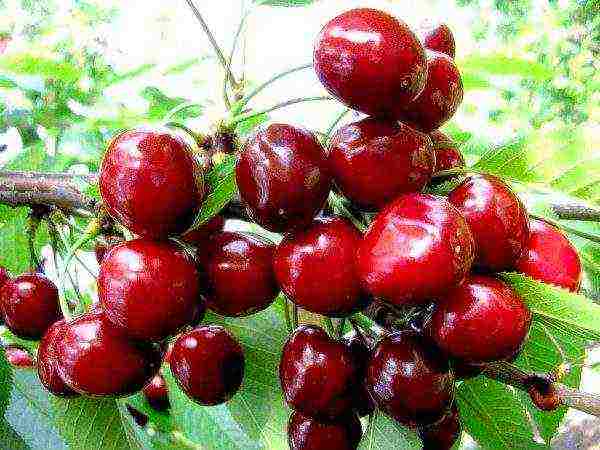
PROS:
- Early ripening of berries
- Large fruit size (weight up to 6-8 g)
- High taste characteristics of fruits (the pulp is dark red in color, juicy, semi-gristly consistency)
- Dessert type
- Universal use of berries
- High level of productivity (62 kg per tree on average)
- High level of frost resistance (-23.5 degrees
MINUSES:
- Height (up to 5 m)
- Wet separation of the berry from the stalk, juice is released
- The level of early maturity is medium (yields a harvest for 5 years)
- Self-infertile variety
- Average level of resistance to diseases, including fungal
Pollinators: Dnieper, Bigarro Burlat, April, June early Skorospelka
Jealous

PROS:
- Medium-sized tree, compact
- The crown has no sharp forks
- Unpretentious in care
- Fruits are distinguished by high taste and consumer qualities.
- Due to the dense skin, the crop is transportable over long distances
- High level of frost resistance (up to -30 degrees)
- High resistance to frost crack, sunburn
- Resistance of the tree to fungal infections
MINUSES:
- Medium late harvest ripening
- Self-infertility
Its best pollinators: Raditsy, Compact, Iput, Venyaminova, Tyutchevka, Ovstuzhenki
Large-fruited
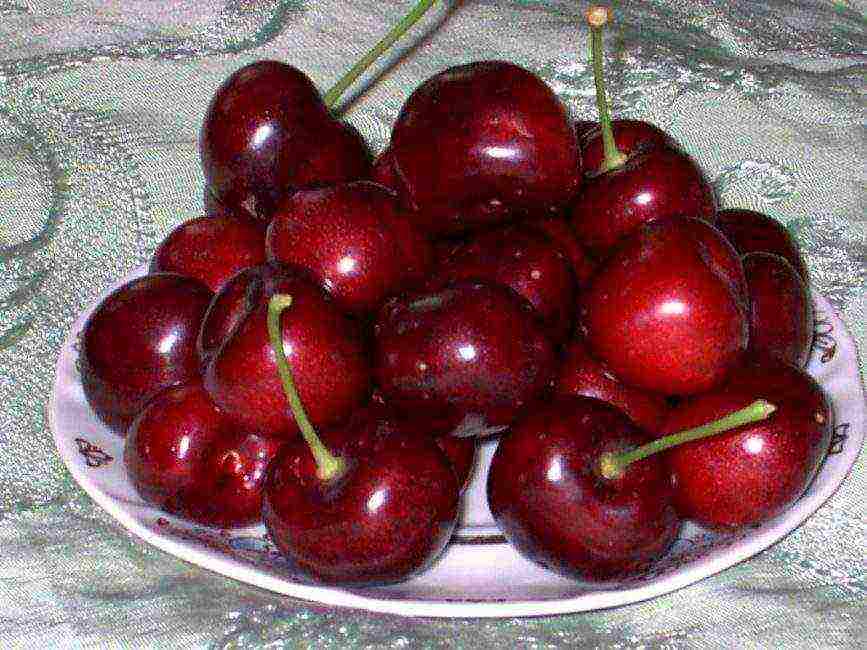
PROS:
- Medium-sized tree
- Fruits are very large in size, their weight is up to 18 g
- Sweet and sour taste, dark red fruit color, medium density pulp
- High product characteristics
- Increased frost resistance
- Dry detachment of the peduncle
- Good transportability
- Not susceptible to moniliosis
- Drought tolerance, no loss of crop flavor
MINUSES:
- Late ripening
- Self-sterile
Top pollinators: Bugaro Oratovsky, Surprise, Francis,
Vasilisa
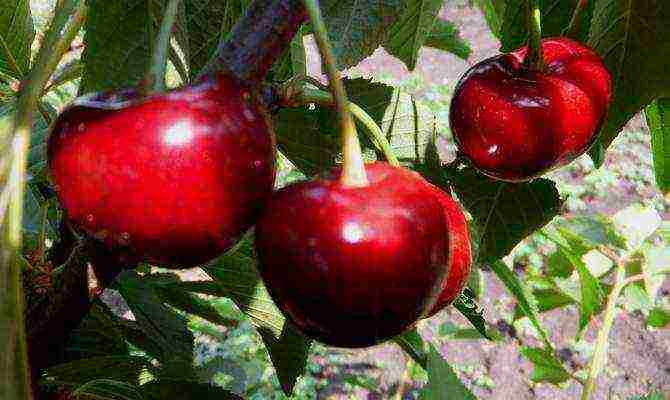
PROS:
- Mid-season
- Very large berries, weighing up to 15 g
- Taste and commercial qualities are excellent (the fruits have a rich red color, glossy shine, the pulp is dense, fleshy, juicy)
- Tasting score 4.5 points
- Duration of fruiting 20 years
MINUSES:
- Berries with heavy precipitation are subject to shedding
- Requires additional pollination
- Low resistance to fungal diseases and garden pests
Top pollinators: Early ripening, Burlat, April, Household, Early Bigarro
Ovstuzhenka
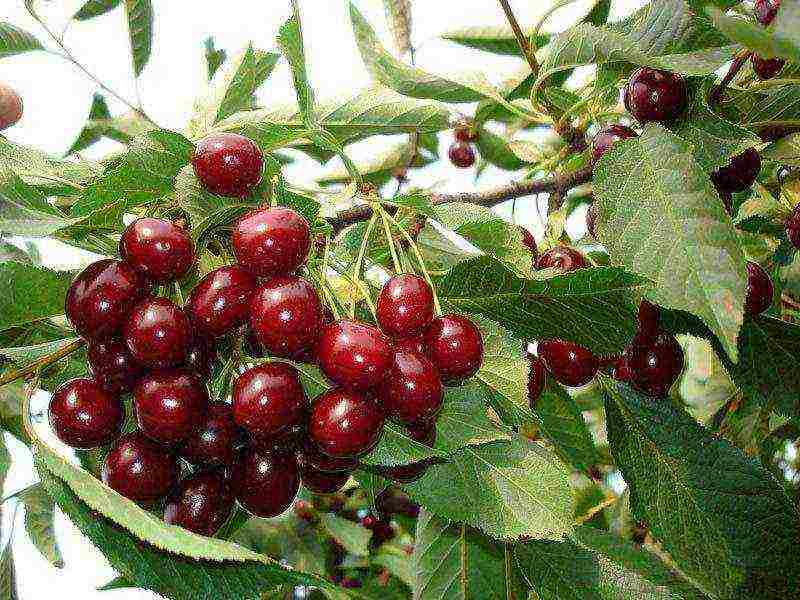
PROS:
- Early ripening of the crop
- It does not require special care
- Medium-sized tree, with a rapid growth rate
- Large berries, weight up to 7 g
- The pulp is sweet enough, juicy
- The color of the berries is dark burgundy
- Product and taste characteristics are high
- Disease resistance is good
- High frost resistance
MINUSES:
- Average yield, on average 15 kg per tree
Regina
PROS:
- Late-ripening variety
- The size of the tree is medium, the growth is gradual
- Does not create difficulties in care and harvesting
- High indicator of presentation and taste
- Berries are not afraid of transportation
- The structure of the berries is firm, the pulp is tasty and aromatic
- The size of the fruits is large, their weight reaches 10 g
- The level of frost resistance is sufficient
- Disease resistance to garden pests is excellent
MINUSES:
- Low rate of resistance to viral diseases
- Requires additional pollination
Pollinators: Karina, Bianca, Sylvia, Nephris, Coral Lotivka
Bull heart

PROS:
- Large-fruited, average berry size 8 g
- The color of the fruit is dark burgundy, the pulp is of medium density, the skin is moderately dense with a smooth surface
- Type of separation from the stalk dry
- Universal purpose of fruits
- High degree of productivity
- The size of the tree is medium, but there are also tall plants.
- The degree of frost resistance is good, up to - 25 degrees
- Not susceptible to coccomycosis
MINUSES:
- Low transport rate despite dense skin
- Berries have a short shelf life, processing is required as soon as possible
- Self-infertile variety
Top pollinators: Tyutchevka, Iput, Ovstuzhenka
Yellow
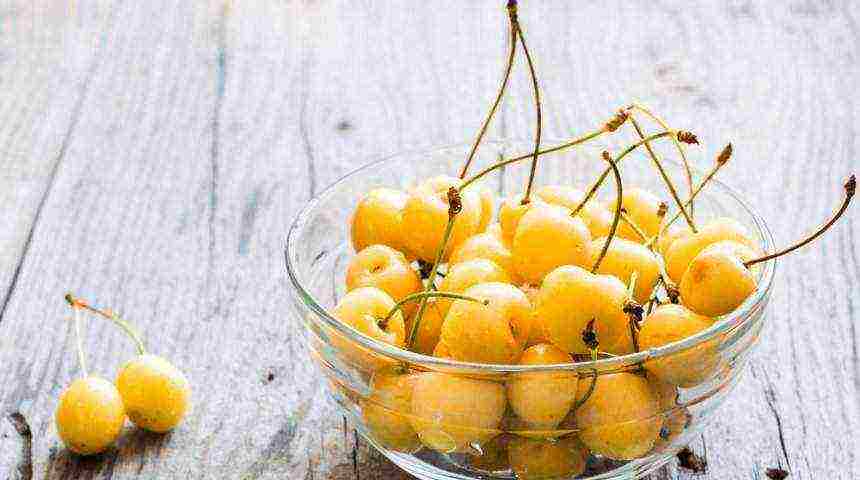
PROS:
- Late ripening of berries
- Increased winter hardiness
- Excellent taste (the pulp is amber, dense structure, juiciness and pronounced aroma)
MINUSES:
- The degree of transportability is low
- The pulp does not separate well from the bone
- Additional pollination required
- Exposed to the invasion of the cherry fly
Pollinators: Bagration, Napoleon pink. Denissena yellow, Cassini early
Early pink
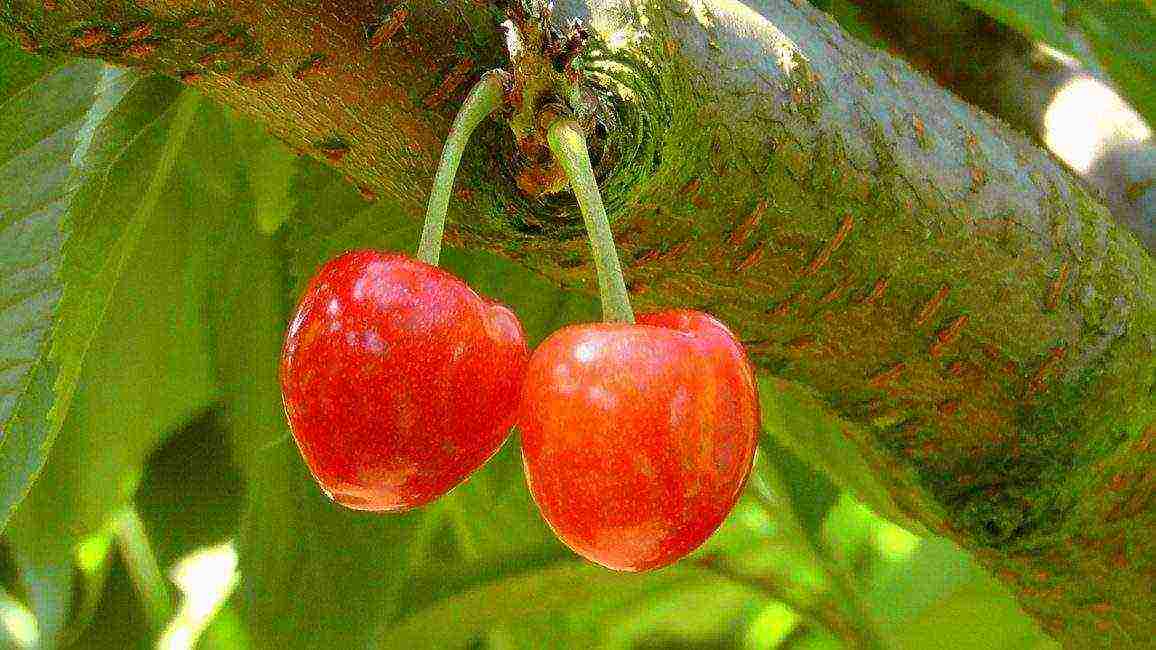
PROS:
- Early ripeness of fruits
- Taste characteristics are high (the pulp is distinguished by a creamy color, the structure is medium-dense, the juice is transparent)
- High resistance to low temperatures
- A fairly good level of resistance to monoliosis, coccomycosis
- Dessert type of berries
- High yield rate, up to 40 kg per tree on average
MINUSES:
- Berries are medium in size, their weight reaches an average of 5 g
- Trees grow up to 5 m
- Low rate of crop transportability
- Poor keeping quality of berries, processing is required in a short time after full ripening
Fatezh
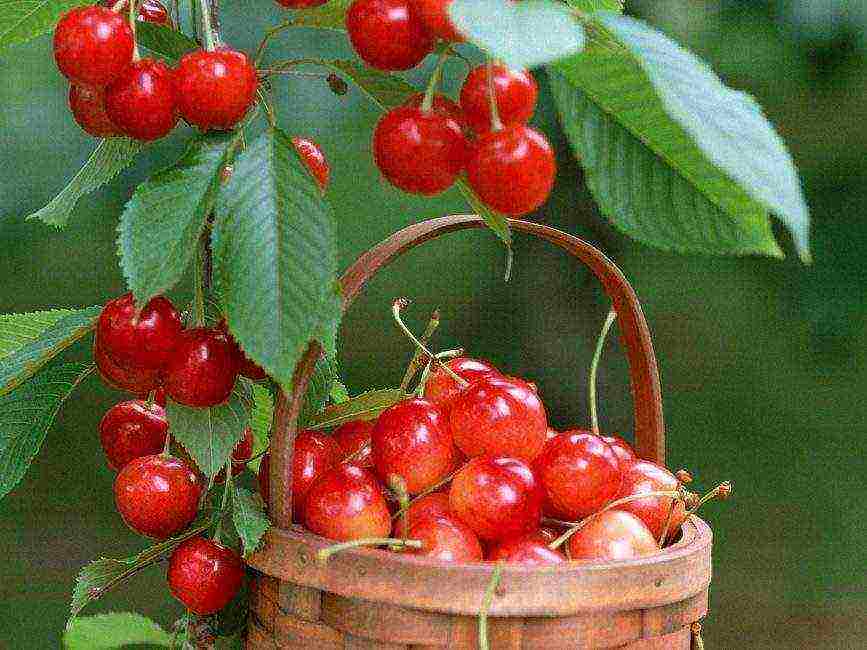
PROS:
- Large-fruited, their average weight is 4.5 g, maximum 6 g
- Fruit tasting score 4.7 points
- The pulp separates easily from the bone
- Fruiting begins at 3-4 years of life of the tree
- The yield indicator reaches 50 kg per tree per season
- The level of winter hardiness is high -30 degrees
- Not susceptible to fungal infections, coccomycosis, moniliosis
- Berries are not afraid of long distance transportation
MINUSES:
- Additional pollination required
Recommended pollinators: Chermashnaya, Iput, Revna, Crimean, Raditsa.
Leningrad black

PROS:
- The variety is medium-sized, the crown is spreading
- The first crop can be harvested in the third year after planting in a permanent place, in June
- Tasting assessment of the harvest 4.2 points
- The taste and market characteristics are high (the average weight of berries is 5 g, the color is dark burgundy, the pulp is sweet, juicy, there is a slight bitterness)
- The purpose of the fruit is universal, excellent for fresh consumption, and for compotes, jam
- High rate of resistance to garden pests and various diseases
- The variety is unpretentious in care
- The increased degree of frost resistance, withstands low temperatures up to -30 degrees
MINUSES:
- Self-fertile variety
- Additional pollination required
Pollinators required: Leningrad yellow, Leningrad pink, Red dense, Fatezh Berries are prone to cracking, with excessive moisture.
Dybera black
PROS:
- High level of productivity, most often up to 90 kg of tasty and aromatic berries are removed from trees, but under favorable conditions, 170 kg of harvest can be removed from one tree
- Fruits are large in size, their average weight is 6 g
- The pulp is of medium density, juiciness, dark burgundy color, there is a slight sourness
- The frost resistance index is quite high, up to -30 degrees
MINUSES:
- Poor resistance to negative temperatures
- Mature trees reach a height of almost 6 m, which makes them difficult to care for and harvest
- The tree begins to bear fruit 5 years after planting in a permanent place
- Requires additional pollination
- Insufficient immunity to various types of diseases, including fungal, to garden pests
- Regular pruning of the crown is required
Recommended pollinators: Drogana yellow, Bull heart, Napoleon pink, Fatezh,
Cordia
PROS:
- "Queen" of late varieties
- Universal fruits
- Taste and commercial characteristics are high
- Berries are large enough, their weight can reach 8-10 g
- Color carmine black, skin tone bronze
- Fruits are not prone to cracking, do not rot
- Excellent long-distance transportation
- When grown on vigorous rootstocks, it grows rapidly
- Productivity is regular, fairly high
MINUSES:
- The variety is self-fertile, additional pollination is required
- There is a need for short pruning, the growth of shoots is significantly enhanced
- Average winter hardiness
- The crop is moderately resistant to cracking
Top pollinators: Van, Summit, Karina, Regina, Burlat.
Tyutchevka
PROS:
- Medium late harvest ripening
- Medium-sized tree, semi-spreading crown, sparse, spherical
- The beginning of the fruiting period falls on 3-4 years of plant life.
- The berries are medium in size, their weight is 5-6 g, but under favorable growing conditions they can reach 7 g
- Taste and commercial characteristics are excellent (the color of the pulp is dark red, the structure is dense, the aroma is pronounced)
- Tasting assessment of the harvest 4.9 points
- The crop is not afraid of transportation over long distances, the keeping quality of the fruits is good
- Resistance to major diseases is good
- The average productivity index is over 97 c / ha, with proper agricultural technology this indicator can reach 275 c / ha
- High level of resistance to moniliosis
MINUSES:
- Low self-pollination rate, up to 6%
- Average degree of resistance to clasterosporium disease, coccomycosis
Top pollinators: Iput, Raditsa, Revna, Ovstuzhenka
General's
PROS:
- Variety with medium-late ripening of berries
- The size of the fruits is large enough, their weight is 9-12 g
- The color is yellow, there is a carmine blush
- The pulp stands out with a sweet and sour taste, dense structure, very juicy
- Tasting score - 4.6 points
- The indicator of drought resistance and frost resistance is very high
- Fruiting begins 3 years after planting in a permanent place
- Unpretentiousness when growing
- Resistance to typical diseases and garden pests is sufficient
MINUSES:
- Fruits cannot retain their taste and marketability for a long time, they do not tolerate long-distance transportation
Pollinators: Tyutchevka, Ovstuzhenka, Iput, Crimean, Lapins
Italian

PROS:
- Self-fertile variety
- Fruits ripen early
- Taste and marketable qualities are excellent (the color of the berries is deep red, the pulp is moderately dense, tender, fleshy, it separates well from the stone)
- Large fruits, weight up to 6 g
- High productivity index
- Resistance to major diseases and garden pests is high
- Good frost resistance, up to - 28 degrees
MINUSES:
- There are no obvious shortcomings, based on the reviews of gardeners
Bakhor
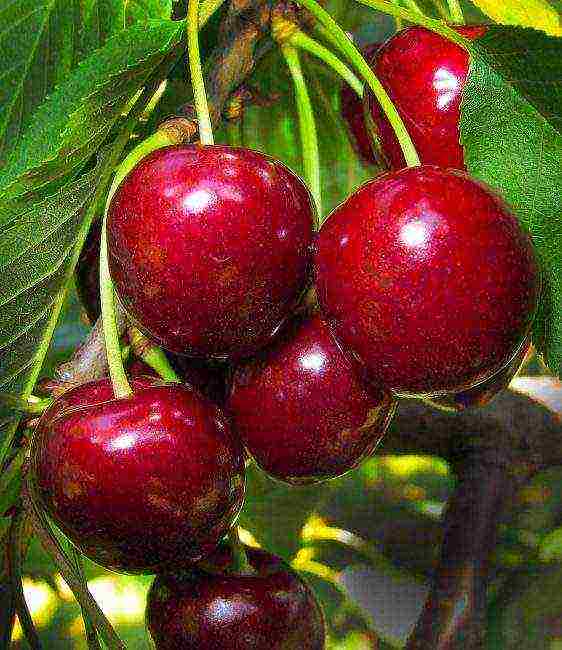
PROS:
- The crop ripens early, in the first - in the second decade of May
- The tree grows very quickly, the degree of leafiness is medium, the crown is round
- Fruiting period begins in the fourth year after planting in a permanent place.
- The size of the fruits is quite large, 8-9 g, their color is dark red, wide-heart shaped
- The color of the pulp is dark red, the structure is medium density, very juicy, it has a sweet taste, there is a slight sourness
- The pulp separates well from the stone
- Due to the dense skin, the crop is not afraid of transportation over long distances, it retains its presentation for a long time
- The fruits can be used both for fresh use and for compotes, jams, preserves.
- Tasting score 5 points
- Dessert type harvest
- Planting material is grown from seedlings
- The indicator of resistance to fungal diseases is good
- Frost resistance is sufficient, up to - 25 degrees
MINUSES:
- Vigorous, height 5-6 m
- The yield indicator is average, up to 45 kg of fruits can be removed from one tree
Farewell
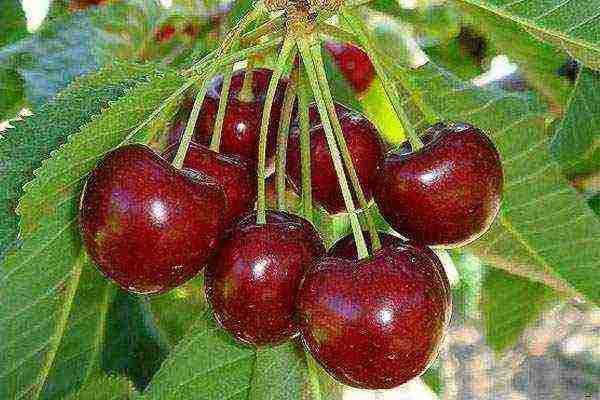
PROS:
- Cherries with early ripening, are very popular among gardeners and consumers.
- It is appreciated for its unpretentious care.
- Excellent taste of fruits, large-fruited, high rate of drought resistance and winter hardiness
- High yield rate, up to 95 kg of harvest is removed from one tree
- The fruits are excellent for fresh use, for winter harvesting
- The size of the berries is large enough, weight up to 13 g
- The color is red, the color of the flesh is yellow
- The taste is sweet, harmonious, the aroma is pronounced, there is a wine-sweet aftertaste
- The pulp is easily separated from the bone
- The tasting score is 4.5 points
- The variety is distinguished by its early maturity
- The yield is high, after 10 years the figure is about 100 kg
- Thanks to the dense skin, which protects the pulp well, the crop can be stored for a long time and is not afraid of transportation over long distances
- High degree of resistance to coccomycosis
- Increased degree of frost resistance
MINUSES:
- The tree is very vigorous, which makes it difficult to pick berries
- The variety is self-fertile, additional pollination is required.
- Average indicator of resistance to fungal infections
Pollinator varieties: Donetsk coal, Valery Chkalov, Donetsk beauty, Sister, Valeria, Donetsk Yaroslavna, Ethics, Rannnya rovinka, Aelita, Annushka, Donchanka
Yaroslavna
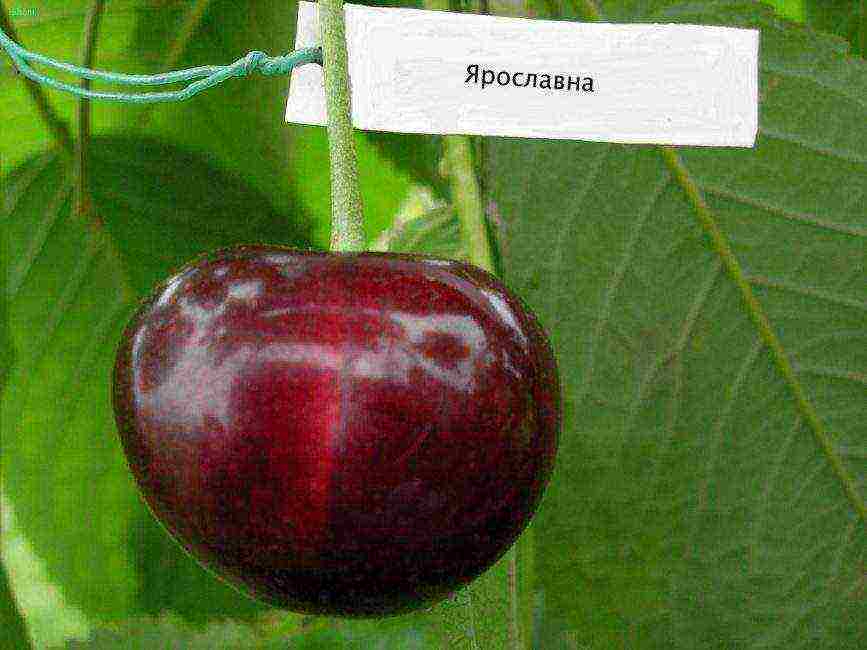
PROS:
- The tree is medium-sized, its height does not exceed 3.5 m
- Does not require special conditions for growing, care
- The yield indicator is high, annual
- Type of separation from the stalk dry
- Taste and marketable qualities are excellent
- Fruit size is large, weight is 8-9 g
- The pulp is very sweet, pleasant, of medium density, red in color
- The color of the cherry pomegranate is red, the stone is small in size, it separates well
- The increased degree of frost resistance, drought resistance, resistance to coccomycosis
- Berries do not crack in conditions of high humidity
- Transportability is good
MINUSES:
- The variety is vigorous, the crown is spherical - spreading, the branches are curved
- Additional pollination required
- Average indicator of resistance to fungal infections
Pollinators: Ovstuzhenka, Raditsa, Iput, Chermashnaya, Fatezh.
7.5 Overall Score
After reviewing the description of cherry varieties, having studied their strengths and weaknesses, you can choose the most suitable option for your personal plot. It is recommended to purchase seedlings in specialized retail outlets, while you need to pay attention to the presence of damage on the trunk and root system. We tried to collect for you the most popular varieties of cherries and give all the necessary information on them. If you disagree with these ratings, leave your rating in the comments with the reasons for your choice. thank you for your participation. Your opinion will be useful to other users.
Add your review | Read reviews and comments
If you cannot boast of a large plot, then when choosing a cherry variety for yourself, you should focus not only on its characteristics (yield, fruit weight, taste, resistance to pests and diseases), but also on its self-fertility.
Self-fertility is the ability of trees to bear fruit without cross-pollination with other tree varieties. Self-fertile cherry varieties will have to be selected by those gardeners who own small plots and are not able to place several varieties blooming at the same time on them for mutual cross-pollination. Unfortunately, not so many varieties are capable of self-pollination.
We have selected the top 7 best self-fertile cherry varieties and ranked them in descending order of self-fertility (from the highest to the lowest value of this indicator). All these varieties will surely delight you with a decent harvest, even far from the "sister" trees.
It is important to understand that the yield of inter-pollinated cherry trees will always be higher than that of self-pollinated plants. This is a specific feature of the culture - in order to obtain the maximum yield variety declared in the description, the sweet cherry needs pollinating varieties.
Backyard yellow
This variety is the leader of our top, as it has the highest self-fertility among the known varieties of sweet cherry. Due to the fact that the size of the tree is medium, and the fruits are tasty and fragrant, the Home Garden is always a welcome guest on any, even a small garden plot.
The yellow color of the fruit will add charm and charm to the garden, decorate the table and diversify the gardener's diet. You won't have to wait long for fruits - trees quickly enter fruiting, are characterized by active growth and high resistance to both diseases and pests, as well as to winter frosts, and even spring frosts.
Sweet cherries of this variety will always provide you with a harvest, because its fruits hang on branches without crumbling or cracking even in rainy weather.
| Entering fruiting | Tree height (m) | Fruit weight (g) | Harvest | Pollinating varieties |
| For 5-6 years | 3,5-4,5 | 5,0-5,5 | Early July | Does not need pollinating varieties |
Bereket
This variety has a high self-fertility, however, to increase the yield, one or a couple of pollinator varieties can be planted with it. The variety was obtained at the very beginning of the XXI century, and therefore is characterized by all the characteristics inherent in modern varieties - high winter hardiness and drought resistance, as well as resistance to pests and diseases.
The trees of the Bereket variety are medium in size, they are suitable for any, even the most modest site. Plants quickly bear fruit and produce beautiful dark red fruits with juicy, surprisingly tasty pulp.
The undoubted advantages of the variety include the high transportability of the fruit, and the absence of the need for formative pruning of the tree, which makes it simply ideal for planting in the country.
| Entering fruiting | Tree height (m) | Fruit weight (g) | Harvest | Pollinating varieties |
| For 4-5 years | 4,8-5,3 | 5,6-6,3 | Start - mid June |
Self-fertile, but when pollinated varieties Iput and Revna the harvest increases |
Goryanka
The variety was bred in the last century, but this does not mean that it is morally obsolete. It will give odds to any, even the most modern cultivator, because its trees have restrained growth, resistance to drought and frost, as well as diseases and pests.
The fruits of this variety are quickly tied after flowering and ripen together, turning into elegant maroon "dresses" with a pleasant, juicy and very tasty pulp.
The variety is remarkable in that it gives good yields, even a single tree is planted on the site. The fruits can be transported over long distances without damage, and the seed in the berries is small and separates very well from the pulp.
The variety is suitable for cultivation in summer cottages and small farms.
|
|
||||
| Entering fruiting | Tree height (m) | Fruit weight (g) | Harvest | Pollinating varieties |
| For 4-5 years | 4,1-4,7 | 6,0-6,4 |
Start - |
Self-fertile, but when pollinated varieties Iput and Revna the harvest increases |
Tyutchevka
A modern cherry variety with a whole complex of useful and necessary signs for any summer resident is both sufficient self-fertility, and the modest size of the tree, and resistance to diseases, pests, frost and drought, as well as early entry into the season of fruiting and, of course, excellent taste and fruit color, which is good in compote, and fresh when full of sweet juice.
The fruits have a bizarre wide-rounded shape, a dark red "outfit" pleasant to the eye and surprisingly juicy, tasty red pulp.
The variety can be advised to plant on your site also because its fruits are very pleasant to collect. The thing is that their stalk is thick and rather long, and the berries themselves break away from it easily, almost without effort, and the ripe ones hang on the branches without falling, as if waiting for you.
Due to the fact that the fruits are well transported, you can easily take them from the dacha to the house.
| Entering fruiting | Tree height (m) | Fruit weight (g) | Harvest | Pollinating varieties |
| For 4-5 years | 4,0-4,3 | 5,3-7,4 | End of June - early July |
Self-fertile, but when pollinated by varieties Ostuzhenka or Raditsa the harvest increases |
Dunn
A rare variety that can boast a complete lack of flaws, Dunn is one of them. The trees stand out among others for their luxurious pyramidal crown, which practically does not thicken and requires only sanitary pruning, for its highest resistance to winter frosts and spring frosts, as well as to pests and diseases.
It is worth planting at least one seedling of the Dunn variety on your site, as soon you will get a good harvest of large and aligned, like a ruler, fruits of a pleasant dark red color.And their flesh will be juicy, tender and so pleasant to the taste that you will eat all the berries unnoticed.
| Entering fruiting | Tree height (m) | Fruit weight (g) | Harvest | Pollinating varieties |
| For 4-5 years | 4,0- 4,7 | 4,5-4,9 | Start - mid June |
Self-fertile, but when pollinated varieties Iput and Revna the harvest increases |
Dolores
A variety with a romantic name that will not leave anyone indifferent. It will be useful to hurry gardeners who are not used to waiting for a long harvest, those who do not want to use a stepladder to pick every last berry, and those who wish to see healthy and luxuriantly blooming plants when they come to the dacha or return to the garden in spring.
Those with a sweet tooth will not be disappointed either - Dolores fruits have all the qualities to satisfy the taste of even the most fastidious cherry lover. Each fruit, like a fresh candy, is “packed” in a maroon wrapper and contains a small, almost invisible bone, which is hidden in a juicy, tasty and fragrant burgundy pulp with a piquant sourness, which does not spoil at all, but on the contrary, gives the taste sophistication.
The fruits are suitable for all types of processing, and the trees are suitable for planting in any, even the smallest area.
| Entering fruiting | Tree height (m) | Fruit weight (g) | Harvest | Pollinating varieties |
| For 4-5 years | 3,5-3,8 | 5,5-6,2 | Mid june | Self-fertile, but when pollinated varieties Iput and Revna the harvest increases |
Pridonskaya
This variety closes our top-7. But do not think that he does not have sufficient self-fertility to produce crops, even if you have a single tree growing on your site. It's not like that at all. Despite the partial self-fertility, the Pridonskaya cherry will supply you with a harvest in the form of very large, one-dimensional fruits of a rich bright red color with pink, slightly gristly and very juicy pulp of a pleasant, refreshing sweet and sour taste.
The variety is also valuable because its yield is stable and annual, because the flowers are not afraid of spring frosts, and the plant itself is not afraid of severe frosts and summer heat.
The variety is suitable for growing both in the country and in an average-sized garden, its trees do not require any pruning except sanitary, and no protection, because they do not get sick and are extremely rarely affected by pests.
| Entering fruiting | Tree height (m) | Fruit weight (g) | Harvest | Pollinating varieties |
| For 5-6 years | 3,8-4,5 | 5,0-6,5 | Start - mid June |
Self-fertile, but when pollinated varieties Iput and Revna the harvest increases |
We have considered the most interesting varieties of cherries that deserve the attention of both amateur gardeners and professionals. The listed varieties have all the features inherent in modern varieties and, moreover, are characterized by high self-fertility, which will allow you to grow on the site not only cherries, but also plants of other breeds. Do not forget that planting trees of self-fertile varieties, like other stone fruits, is best in spring.
Foreword
There are many varieties of cherries today! In the south of Russia, more thermophilic trees are grown, and for the Moscow region and regions of the middle zone, it is better to choose frost-resistant plants. How not to get confused in the variety of cherry varieties and find the best one for your garden, we will tell in this article.
The best self-fertile varieties for the Moscow region and the middle lane
Self-fertility of varieties lies in the ability of fruit trees to self-pollinate with their pollen. Self-fertile are those that form 20-40% of the total number of flowers. Self-fertile varieties do not need cross-pollination with other varieties. Their advantage is that they are independent of the flight of pollinating insects.

Self-fertile cherry
But today there are not so many self-fertile varieties of sweet cherries. Therefore, even with such trees, it is better to plant pollinating varieties near, which in any case will help to increase yields.
The best varieties of self-fertile cherries for the Moscow region today are recognized:
- Narodnaya Syubarova is considered the best option throughout Russia. True, one should not expect a huge harvest, 50 kilograms from one tree is the limit, it is no longer possible to harvest even in the most successful year. The berries of this sweet cherry are of medium size. The tree itself is tall, with a powerful trunk and branches that can withstand the load from snow or wind. The plant is highly self-pollinated, fruits ripen up to 90%. Saplings take root well and are able to grow even on sandy loam and loamy soils.
- Ovstuzhenka is a frost-resistant sweet cherry that can withstand up to -45 degrees, Conditionally self-fertile, since pollination takes place within one tree, the resulting ovaries are no more than 90%. Medium large berries, 4 to 7 grams. The yield is 30-50 kg per tree. The tree is not tall, which allows it to be grown on an industrial scale.
- Revna is a small plant with a pyramidal crown. Self-fertile, very fertile, not large-fruited, its berries are not large, but very sweet and aromatic. Cold-resistant, withstands frost down to -6 degrees during the flowering period. Possesses high transportability, shelf life for a long time, dense, not watery at the stage of maturity.
Early winter-hardy and late cherry varieties
Almost all known cherry varieties are mostly self-fertile, and only a few species are self-fertile, and then only partially, since they also require pollinator varieties for a full harvest. Therefore, when choosing a variety for planting in your garden, you need to immediately buy a pollinator plant with it in pair, which will have the same flowering period. Sweet cherry is divided into 3 groups according to flowering time.
Winter-hardy early cherry varieties:
- Iput - frost-resistant, has good fruits. Pollinators can be Revna and Raditsa.
- Household yellow - self-fertile variety, frost-resistant, vigorous, slow-fertile, quite fruitful. The berries are medium, sweet and sour.
- Gronkavaya is a strong, frost-resistant variety. The fruits received a high dessert rating. Suitable pollinators: Cheremashnaya, Raditsa, Iput, Fatezh and Ovstuzhenka.
- Red hill - less resistant to diseases, berries were highly appreciated. Pollinators, like Iput's.
- Ovstuzhenka - refers to partially self-fertile varieties, fruits with a good score. It is good to plant next to Iput cherries.
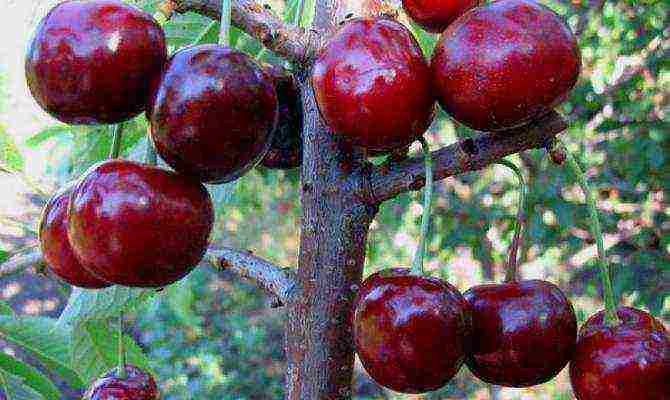
Winter-hardy cherry variety "Iput"
Mid-season cherry varieties:
- Rechitsa - belongs to the varieties of the bigarro group, frost-resistant, not large-fruited, with very sweet dark red berries. Disease resistant. From pollinators it is better to choose Pink Pearls, Adeline and Ovstuzhenka.
- Leningrad black from the guinea group. Sweet medium-sized berries, with pulp inseparable from the seeds. A tree of medium height, unstable to frost, not capable of self-pollination. Pollinators: Iput, Revna, Bryanochka, Tyutchevka and Veda.
- Leningrad pink - also belongs to the gini group. Small berries with a delicate, yellowish skin with ruddy barrels, the flesh is sweet and yellow. The plant is quite tall, has a lush crown, does not self-pollinate. It is recommended to plant next to the following varieties: Adelina, Chernyshevsky, Pink Pearl and Rechitsa.
- Tyutchevka is a medium-sized tree, very resistant to cold and disease. The berries are bright red, of medium size, well suited for freezing and transportation. The plant is partially self-pollinated. Recommended pollinators: Iput, Raditsa and Ovstuzhenka.
- Large-fruited - a tall, fast-growing tree with a broad-shaped crown of medium density. Large-fruited cherry has dark red berries, the weight of which is 10-12 grams, it is considered a dessert variety. The best pollinators will be Surprise and Oratovsky.
Late ripening varieties:
- Michurinka is not a tall tree that is resistant to drought and disease. The berries are dark red in color, strong, fleshy and sweet. Stored for a long time and well transported.The variety is self-fertile. Pollinators required: Michurinskaya late and Pink pearls.
- Bryansk pink - belongs to the bigarro group. The berries are medium-sized, about 5 grams, with a sweet pink pulp that cannot be separated from the stone. For pollination, the following varieties are suitable: Iput, Revna, Ovstuzhenka and Tyutchevka.
Yellow cherries that are not afraid of birds
Red fruits of cherries, especially early varieties, are very fond of pecking birds. If the garden is located near the forest, rowan thrushes arriving from it are capable of destroying the entire berry crop in a matter of hours. Therefore, it is better to cover the red-fruited varieties of the Moscow region with a net during the period of their fruiting.
Yellow cherries are not afraid of this misfortune - the birds do not touch its berries, and the harvest remains intact. In addition, red fruits do not tolerate heavy summer rains and often crack. The yellow cherry, in contrast to the red-sided cherry, does not have such a disadvantage.

Yellow cherry
The most common cherry variety in the Moscow region is “Zheltaya Priusadebnaya”. She is from the early maturing varieties of the bigarro group. The berries are of medium size, weighing about 5-6 grams, their pulp, like the peel, is yellow, sweet, but with a slight sourness. Yellow Household loves black soil, so it takes root well in the middle lane.
Features of the variety:
- self-pollinated tree, has high yield rates;
- fruiting begins quite late - at the 6th year, while ordinary trees begin to bear fruit in the fourth year;
- frost-resistant variety, resistant to fungal diseases, not afraid of cherry flies;
- requires frequent pruning and removal of shoots, since the tree multiplies quickly and has a very lush crown.
Low-growing trees - small, but remote
To achieve high yields on a small planting area, columnar fruit trees are increasingly used, since there is less maintenance and consumption of related materials, and mechanized harvesting is also applicable to them. Among the thousands of cultivated varieties known in the world, tall ones prevail.
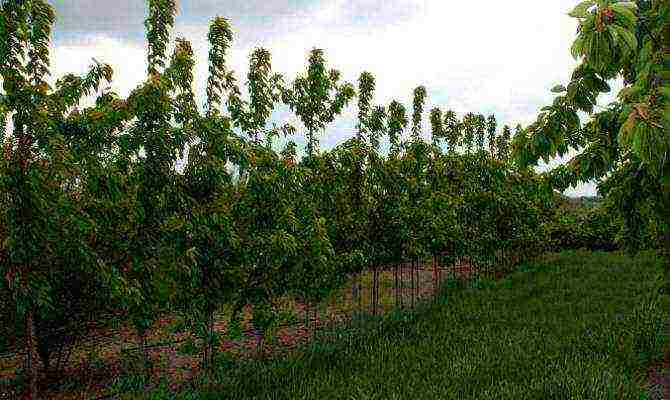
Columnar fruit trees
And only a few of them, such as the yellow Fatezh cherry, have a relatively moderate growth. To breed low-growing sweet cherry varieties, modern breeders have used several methods of suppressing the dominant gene of tallness. We will tell you about two of them.
- Growing dwarf donors. Cultivated large cherries are usually grown on antipka seedlings, which are vigorous rootstocks. Low-growing rootstocks are used to reduce the height of the tree. Clonal cherry rootstocks known today have a wide range of possible crown reduction, which is 20-90%. The effectiveness of the use of low-growing rootstocks has been noted by world breeders, industrial gardeners and private farms. Thanks to the latest research, the promising use of dwarf cherry rootstocks was confirmed, which influenced the further development of breeding in this direction.
- Exposure of test specimens to radiation. This method is based on causing a mutation in plants that suppresses the dominant traits of their tall stature. As a result of the work of Canadian specialists, low-growing varieties of cherries were bred - dwarf Compact Lambert and Compact Stella. The resulting columnar forms have earlier periods of full fruiting than large-fruited tall cherries.
But, despite many advantages, even the best columnar varieties have a number of disadvantages. Flower buds of weakly growing cherry rootstocks have low resistance to spring frosts, which often leads to a noticeable loss of part of the crop. In addition, the buds of dwarf trees bloom earlier than those of tall plants, which can lead to the threat of freezing.
Another significant disadvantage of the columnar sweet cherry is its over-yielding capacity, since the fruits ultimately lose significantly in size, which affects their market value. To prevent this phenomenon, the crowns of columnar trees need to be regularly adjusted to regulate the load on the crop.
Rate the article:
(2 votes, average: 4.5 out of 5)
Sweet cherry is one of the most popular garden crops for growing on a personal plot. The yield and taste of berries largely depends on the choice of varieties for a particular region. Today, dozens of different varieties of this culture have been bred, with their own advantages and disadvantages. In the article we will consider the best varieties of cherries for central Russia, describe the features and photos of berries.
What to consider when choosing a cherry variety?

When choosing a cherry variety for central Russia, many factors must be considered:
- You should pay attention to winter hardiness. Sweet cherry is a thermophilic plant that can die during frosts. The higher the frost resistance of the variety, the better.
- It is advisable to purchase low-growing varieties - they have a more productive yield in an unfavorable climate, since most of the nutrients are spent on the formation of berries, and not on the crown.
- It is recommended to choose varieties that have a late flowering period - in conditions of middle latitudes, there is a prolonged spring and a late onset of stable high temperatures.
- Self-fertile varieties that do not need cross-pollination with other members of the species are best suited.
The best varieties
Breeders have bred several dozen varieties and hybrids of sweet cherries with different characteristics, productivity and adaptive abilities. Consider the descriptions of varieties for cultivation in the middle latitudes of Russia.
Iput
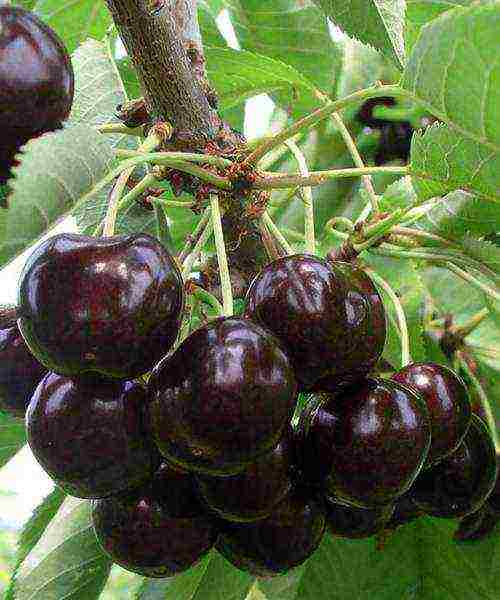
A fast-growing sweet cherry variety, bred by domestic breeders at the Research Institute of Lupine. It has been used for cultivation since 1993. The tree is medium-sized, reaching 4-5 meters in height.
The crown is dense, has a pyramidal shape, the leaves are elongated, elliptical with pronounced serration. The petioles are thick and short, on which there are 3-4 large flowers with white petals.
Flowering begins in May, the first harvest can be taken by mid-June. Fruits are large, blunt, heart-shaped, weighing up to 6.3 g. The skin is glossy, colored dark red. The pulp is juicy and tender, has a sweet dessert taste. The variety is versatile in application. Average productivity is 25-30 kg / tree.
The variety is winter-hardy, resistant to fungal diseases. Self-infertile type of pollination.
Jealous

A mid-late variety bred at the Research Institute of Lupine by crossing seedlings of Bryanka pink cherry with other species. Recommended for cultivation in the Central Region.
Medium-sized trees with a pyramidal crown. Begins fruiting from 5 years. In spring, many ovoid leaves with jagged edges are formed on the shoots. The petiole has embossed veins and is colored brownish-pink. Flowering begins in mid-May, fruits ripen from early June. The variety is partially self-fertile, the proportion of self-pollination does not exceed 5%.
The fruits are of medium size, have a flat-round shape and an average weight of 4.7 g. The skin is very dense, dark red in color. The pulp is red in color, has a dense consistency and dessert taste, a medium-sized pit. The variety has high indicators of transportability.
Winter hardiness is above average, there is resistance to temperature extremes and sunburn. There is a high resistance to fungal diseases.
Fatezh

A mid-early variety bred at the All-Russian Institute of Selection and Technology by free pollination of Leningradskaya yellow sweet cherry. Listed in 2001, suitable for cultivation in the Central Region.
The trees are medium-sized with a height of up to 5 m. The crown is spherical, spreading and of medium density. The leaves are lanceolate, have finely serrated serration. White flowers, fruit ovaries are formed both on bouquet branches and annual shoots.
Flowering begins in late May, fruits are formed from the second decade of June. The berries are rounded, weighing up to 4.4 grams. The pulp is light yellow in color, with a juicy and dense structure. The stone is light, medium in size, well separated during processing. The taste is dessert type, has a sweet and sour aroma. The variety has a high yield - up to 30 kg / tree.
Winter hardiness is above average, there is no susceptibility to diseases. There is immunity to fungal diseases. The cultivar is self-fertile. The main disadvantage is the tendency to gum flow.
Tyutchevka

Late ripening variety, bred in 2001 at the Research Institute of Lupine by crossing Red dense cherry.
The tree is of medium height and fast growth rate. The crown is rare, spherical, depending on the place of cultivation, it can be spreading or semi-spreading. The leaves are large in size with a strongly pointed tip.
Fruiting occurs on bouquet branches. Flowering begins by mid-summer, fruiting by late July or early August.
Large fruits have a spherical shape and an average weight of 5.3 grams. The skin is dark red, small specks are acceptable. The pulp is red, with a dense and cartilaginous structure. The berries have a sweet taste with a high tasting rating. The maximum productivity occurs after 4-5 years of growth, the yield is up to 40 kg / tree.
It has a high level of winter hardiness and resistance to fungal diseases. The variety is sterile, the quality of self-pollination does not exceed 6%. The main disadvantage is the cracking of the fruit in humid climates.
Bryansk pink
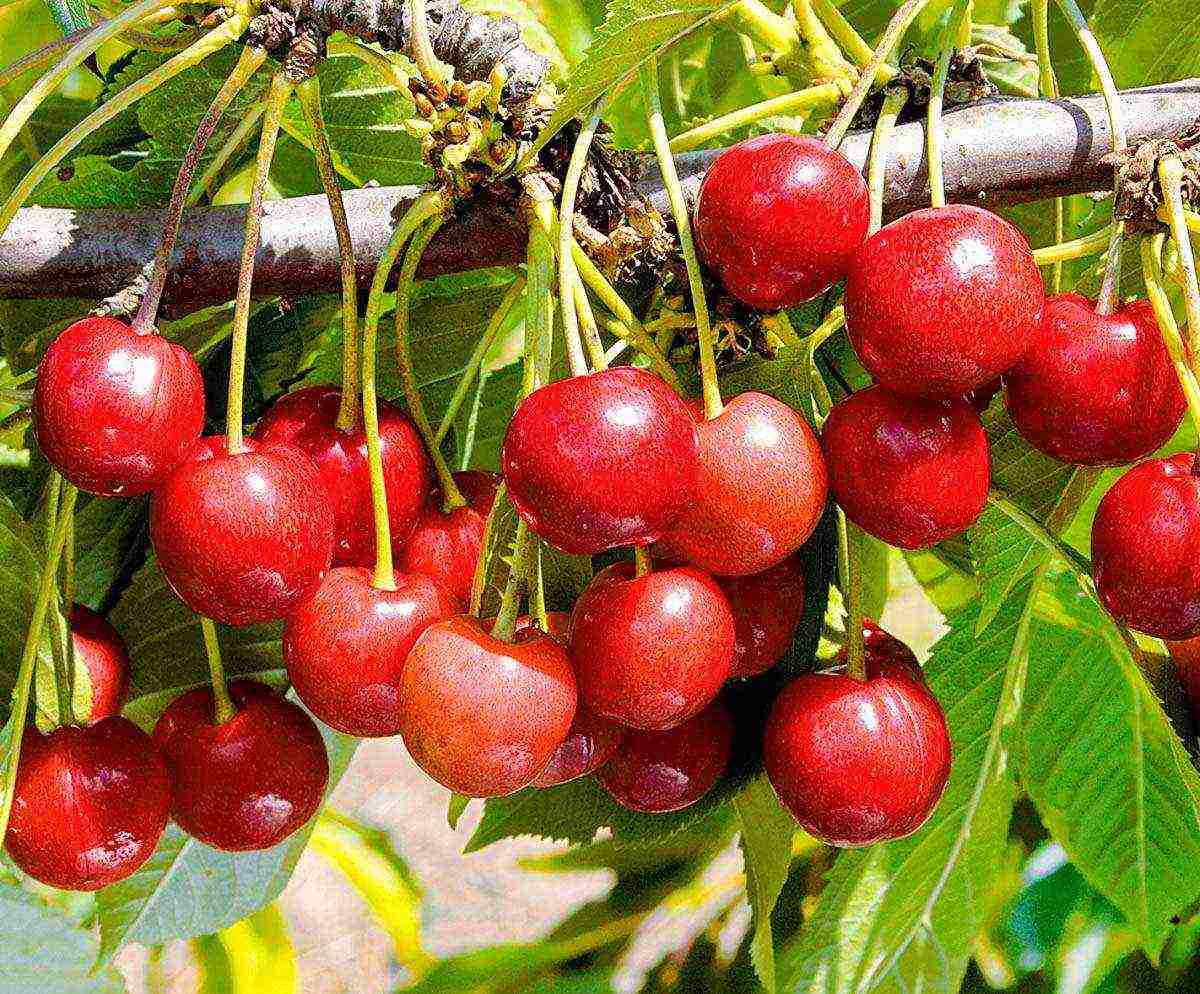
A late-ripening variety bred at the Research Institute of Lupine in 1987. Obtained on the basis of crossing cherry seedlings of the Black Muscat variety (Negritenok).
Sweet cherry is represented by a medium-sized tree with a raised pyramidal crown. The leaves are large, have a pointed top and a double-serrate serration. Fruits are formed on bouquet branches and annual shoots.
Flowering begins in mid-May, ripening of fruits - from the second decade of July to early August. Fruits are medium in size, round in shape. Average weight - 4.0 g. The skin is dense, pink-yellow in color. The pulp is of a dense, cartilaginous consistency, with decent taste characteristics. The variety has universal application, the fruits tolerate transportation well. Productivity - up to 30 kg / tree.
The stem and base of the tree has a high winter hardiness. There is a high immunity to fungal diseases of stone fruits. The variety is self-fertile, resistant to cracking.
Crimean

The variety was bred by domestic breeders in the Tula region, little is known about the history of its origin. In middle latitudes, it is used relatively rarely due to the presence of more productive crop varieties.
The tree reaches 3.5 m in height, is of medium size and spherical in shape. The berries ripen early, starting in mid-June. Fruits are small up to 2 g, have a dark red color. The pulp is juicy and tart; due to its specific taste, it is often used for making wine and compotes. Productivity - up to 7.5 kg / tree.
Crimean cherry is winter-hardy and is often used not for harvesting, but as a pollinator for other fruitful varieties.
Oryol pink

The variety was bred in 1999 by domestic breeders by free pollination of the Narodnaya sweet cherry. Recommended for growing in mid-latitudes.
The tree has an average vigor, its height reaches 3.5 m. The crown is pyramidal, slightly raised. Flowering begins in the second decade of May, the fruits ripen by mid-July. Fruiting occurs on fruit twigs and last year's shoots.
The berries are round, weighing up to 4 g. The skin is dense, pink in color. Inside there is a pinkish pulp with medium density. The stone is large, up to 4.5% of the weight of the fetus, it separates well. Dessert variety, received average tasting ratings.
The variety is self-fertile, has a high winter hardiness. Resistance to fungal diseases of stone fruit crops is relatively low. Productivity from a tree - up to 42 kg.
Narodnaya Syubarova
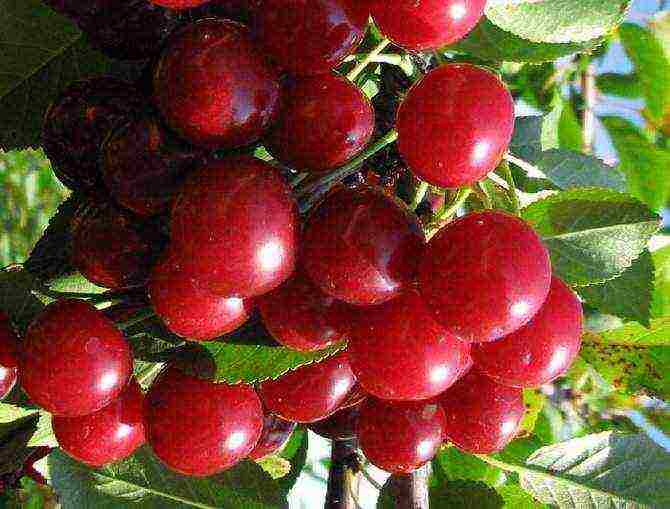
The variety was bred in Belarus by the famous breeder E.P. Syubarova. It is considered one of the best for growing in mid-latitudes and central regions of Russia.
The tree is strong and tall, due to which the resistance to wind and snow load increases, the branches are well developed. Saplings take root in any soil, even in marginal loam and sandy loam soil. The variety is completely self-fertile, does not need other pollinators. Begins fruiting in 3 years, the berries are formed by the second decade of July.
Fruits of medium size, weighing up to 6 g. The skin has a deep red color, pronounced shine. The pulp is red, juicy and tender. Received high tasting marks. The stone is small, well separated from the pulp.
The variety is winter-hardy, withstands severe frosts. Resistant to most typical diseases, cracking of fruits is not observed in hot seasons. Productivity - up to 50 kg / tree.
Ovstuzhenka
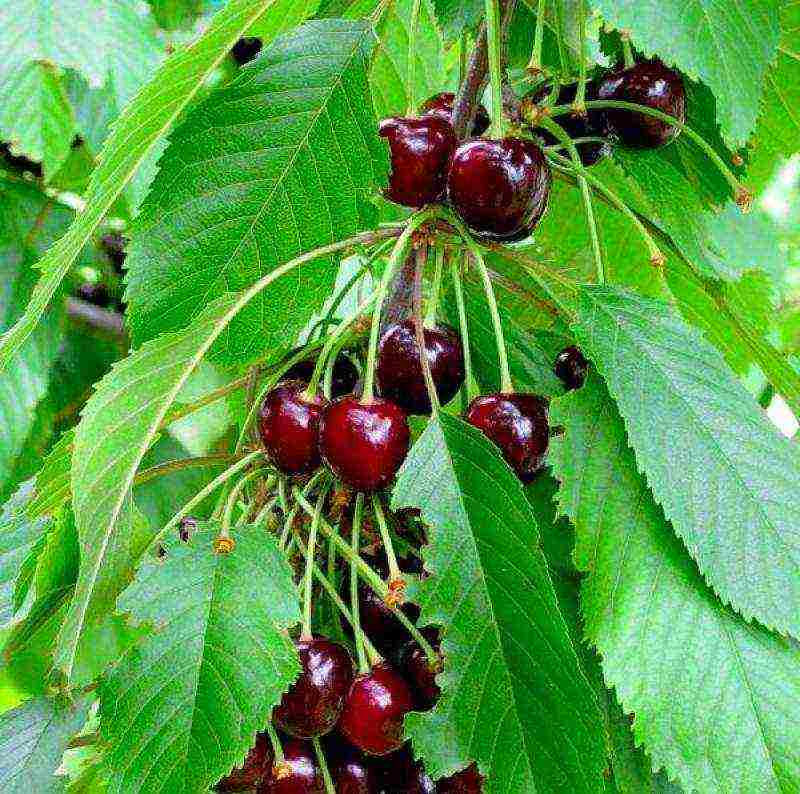
The variety was bred in 2001 at the Research Institute of Lupine using the hybridization of cherries of the Leningradskaya Black and Compact Venyaminova varieties. Suitable for cultivation in the southern and central regions, high yield rates have been identified in the black earth regions.
The tree is small in size but grows quickly. The crown is raised, spherical in shape. The leaf blade is ovate with double-serrate serration. Ovaries are formed only on bouquet twigs.
Large fruits can reach a weight of up to 6 g, the shape is oval or round. The skin is dense and shiny, has a dark red tint. The bone is small and can be easily separated. The pulp is deep red in color, has a sweet taste and a high tasting rating. Withstands transportation well, the variety has a universal purpose. The maximum yield is 30 kg / tree.
High rates of winter hardiness are observed, immunity to fungal diseases of stone fruit crops is developed. Low self-pollination, it is necessary to have other varieties nearby.
Gronkovaya
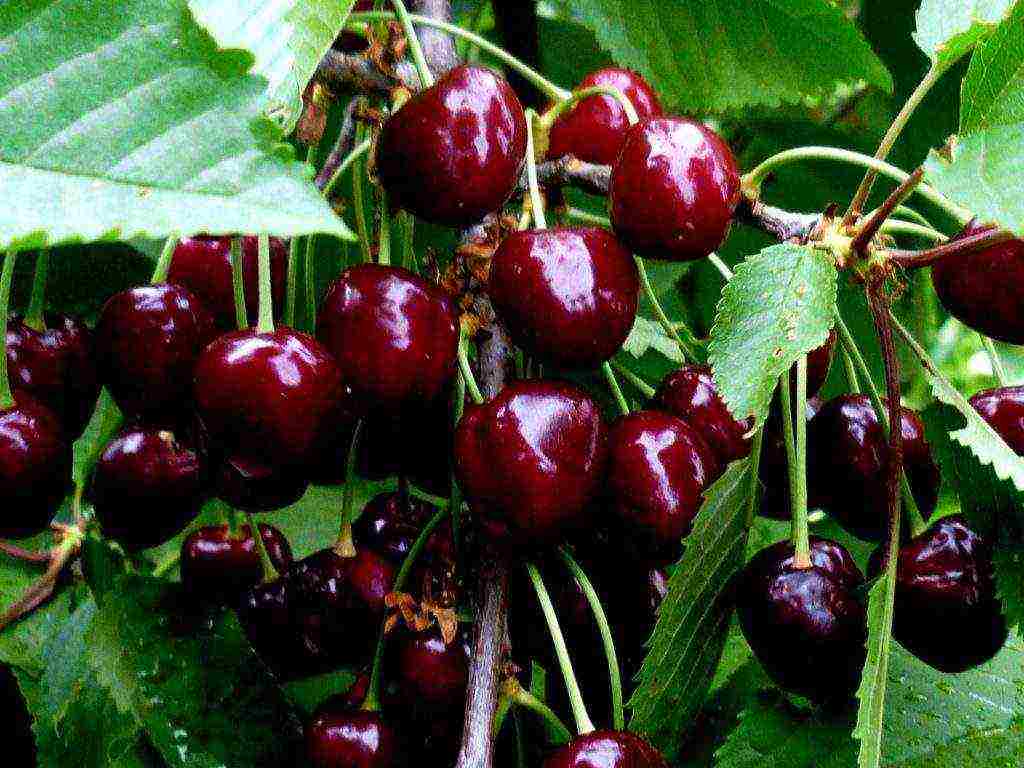
The variety was obtained by free pollination by Belarusian breeders in 1999. Widely distributed in the North Caucasus region and the Astrakhan region.
Sweet cherry is represented by a medium-sized tree with a wide-pyramidal crown. During planting, it is recommended to increase the space between the trees to avoid darkening. Fruiting begins in 3-4 years, harvesting is possible from the end of June.
The berries are even heart-shaped, the average weight of the fruits is 4-5 g. The skin is dark red in color with a pronounced waxy bloom. The pulp is rich red, medium density. The peduncle and stone are easily separated. The taste of the fruit is sweet and has average tasting ratings. Sweet cherries for universal use.
The variety is characterized by increased resistance to frost and disease. The tree is self-fertile, planting of pollinators is required. The yield is high - up to 20 kg / tree.
Backyard yellow
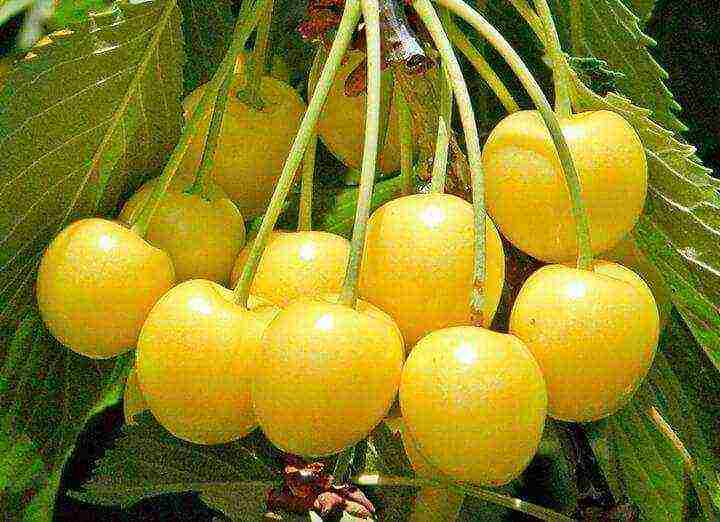
Variety of early ripening, bred at the Research Institute of Genetics and Breeding. IV Michurina in 1998 by crossing the Leningradskaya red and Zolotaya Loshinskaya cherries. Recommended for cultivation in the Central Region.
A fast-growing tree with a spherical crown of medium density. The leaf is large, has an oval-conical shape and a concave plate. Begins fruiting from the 6th year of life.
The fruits have an oval shape and a wide funnel, the average weight is 5.5 g. The skin is yellow without integumentary points. The pulp is juicy, gives an almost colorless juice. The berries have received high tasting ratings and are used for table purposes.
The variety is self-fertile, has high frost resistance. The fruits do not crack in humid climates, have an attractive appearance and good transportability.
Red hill
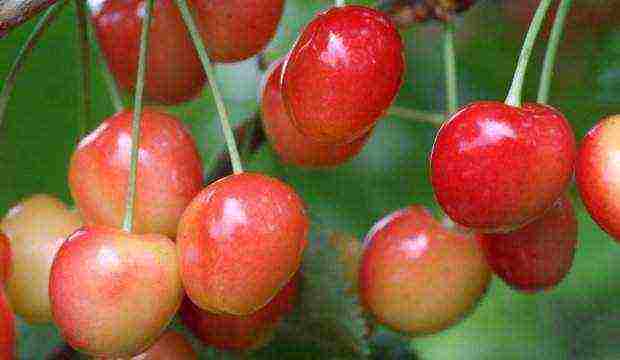
Bred at the Research Institute of Lupine under the guidance of the famous breeder M.V. Kanshina. Successfully passed field trials for cultivation in the Central Region.
The tree is weak, reaching a height of up to 3 meters, the most active growth is observed in the first year of life. The crown is dense, ovoid. Leaves are oval in shape, have a pointed end. Fruit formation occurs on fruit and growth shoots. Flowering begins in early May, fruiting - in the second decade of June.
The berries have a traditional heart-shaped shape, the average weight is 5-6 g. The color of the skin is golden with a pronounced red blush. The pulp is devoid of pigment, the stone is well separated during processing. Application - table, fruits received high tasting marks.
The cultivar is self-fertile. Possesses high immunity and winter hardiness. The yield is high - up to 45 kg / tree. The main disadvantage is poor transportability and short storage time.
Rechitsa
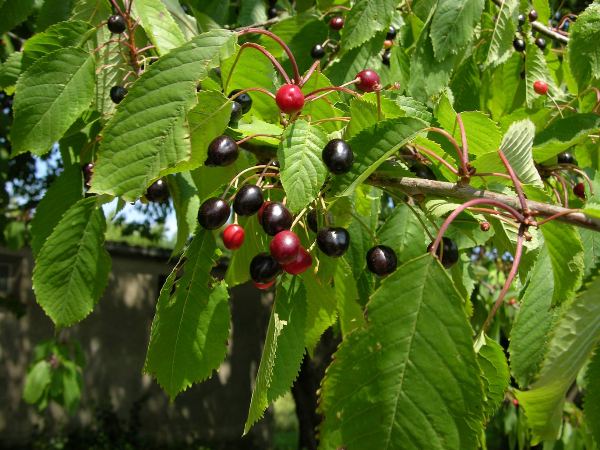
The variety was obtained on the basis of marker characters when growing sweet cherries Bryanskaya rozovaya. The development was carried out at the Research Institute of Lupine. Included in the official register in 2001.
The tree is fast growing. The crown is pyramidal, medium density. The leaf plate is green in color, has the shape of an ellipse. Fruiting is observed only on bouquet branches; it begins to bear fruit from the 5th year of life. Average ripening and flowering period.
The berries are round in shape, can reach a weight of up to 4.9 g. The color of the skin is almost dark red, almost black. The pulp is dense, inside which there is an oval bone. The berries are juicy and sweet to taste, universal use. Productivity up to 23 kg / tree.
Winter hardiness is high, there is resistance to characteristic fungal and infectious diseases of stone fruits. The variety is self-fertile, pollinators are required.
Leningradskaya

An early ripening variety bred at the Pavlovsk experimental station of the VIR. It is one of the first varieties of sweet cherry with high winter hardiness.
The trees are medium-sized, up to 4 meters high. Crohn's medium, wide pyramidal shape. Active fruiting begins at 3-4 years of age. In the conditions of the middle latitudes of Russia, ripening is observed from the second decade of July.
The berries are round in shape, weighing up to 3.5 g. The skin has an almost black color and a pronounced gloss. The pulp is fibrous, tender and juicy in taste. Tasting ratings are average, often used for preparing drinks.
The variety is extremely frost-resistant. Fruit shedding is extremely rare, in combination with a high yield (up to 40 kg / tree), it is one of the best varieties for the Central regions of Russia.
Large-fruited
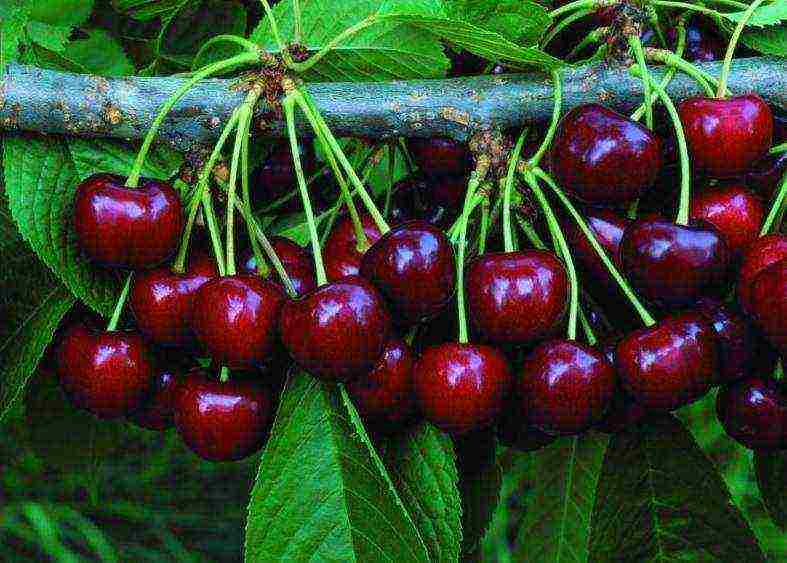
Bred in the 80s of the last century by Ukrainian breeders by pollination of a number of sweet cherry varieties. The fruits have received awards at various exhibitions several times.
The tree shows rapid growth at a height of 4-5 m. The crown is spherical with an average volume of foliage. The leaf plate is strongly elongated, has a pointed top. Fruits are formed on bouquet branches and last year's shoots. Begins fruiting from 4 years old. Late ripening period.
The berries are very large, they can weigh up to 13 g. They have a rounded shape and a dark red skin color. The pulp is dense, has medium cartilage. Taste - sweet and sour, average tasting ratings are obtained. The stone is large, but easily separated from the fetus. The type of application is universal.
This variety is often used for fresh sale as it has a long shelf life. Cracking of the crop is possible during wet seasons. Sweet cherry has a weak resistance to bacterial diseases, the indicators of frost resistance are high.
Michurinka

A hybrid variety obtained by employees of the N.N. Michurina by crossing Leningradskaya yellow cherries.
The tree is of medium height. The crown is oval, less often rounded.The leaf is in the form of an ellipse, there are no stipules, a strongly pointed tip is often formed. Begins fruiting after 5 years, late ripening of berries.
The fruits have an average weight of up to 4.7 g, heart-shaped. The color of the skin and pulp is dark red, the stalk is medium in size. The pulp is quite dense, inside which there is a large bone. The berries are sweet in taste and retain their presentation for a long time.
There is a relatively high resistance to fungal diseases and frost. The type of application is universal, often used for fresh consumption.
Italian
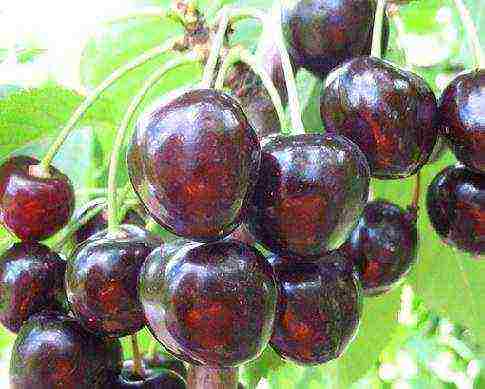
A variety of early ripening, bred by specialists from the N.I. Michurin by crossing the Bigarro and Slava Zhukov cherries. Field tested in 1995.
The tree is of medium vigor. The crown is pyramidal, the flowers are large and white. It begins to bear fruit in 4-5 years after planting.
The berries are large, the average weight is 6 g. The fruits are dark red, the skin has a waxy coating. The pulp has a pleasant taste and dense texture. Quite high tasting marks were obtained. The sweet cherry is easily separated from the stalk, does not crumble during the harvest period.
The variety is known for its high yield, it has resistance to a number of fungal diseases. Average frost resistance, used for fresh consumption and for the preparation of juices and preparations.
Lena
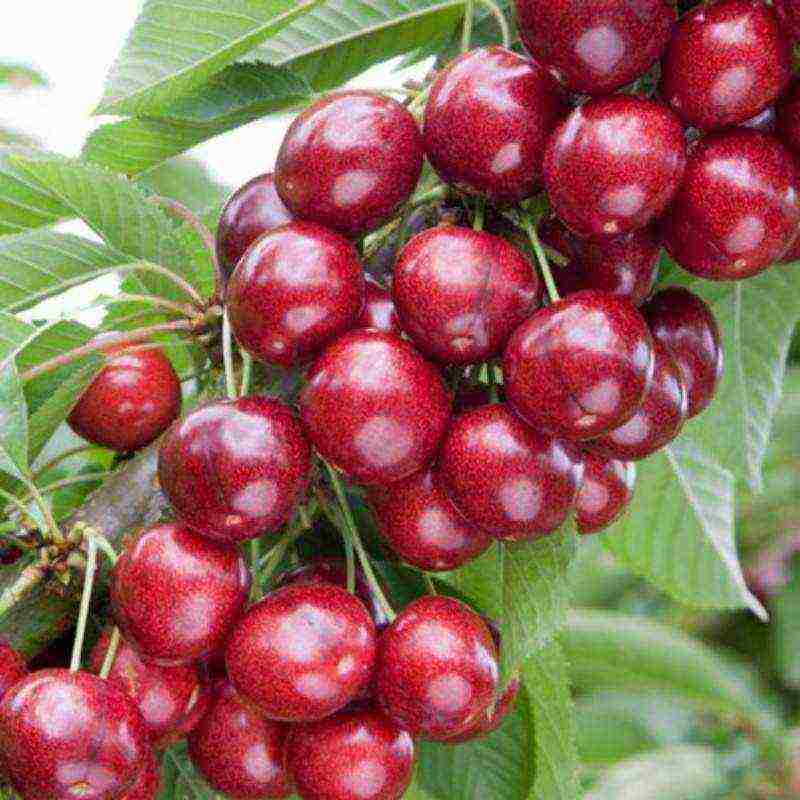
Hybrid variety of late ripening, obtained from sweet cherry Bryanskaya rozovaya. The development was carried out at the Research Institute of Lupine. All tests were passed in 2006.
The tree shows average growth rates, height up to 4 m. The root is oval, has an average density. The variety is self-fertile, fruiting occurs 4 years after planting on bouquet branches.
The berries are heart-shaped, the average weight is 6 g. The color of the skin is black-red, with a slight waxy bloom. The pulp has a sweet and sour taste, high tasting ratings. Recommended for fresh consumption, however, the type of application is universal.
Productivity is maintained only for 7 years, then it is necessary to vaccinate or transplant. There is resistance to fungal diseases and frost.
Sadko
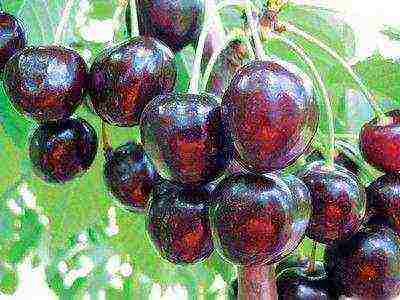
An early ripening variety obtained at the Research Institute of Lupine by crossing several hybrid varieties of sweet cherries. Tested in 2005 in the Central region of Russia.
The tree has medium growth characteristics. The stem is prone to peeling, the crown is rounded. Fruiting is observed starting from 4 years after planting. Berries are formed on fruit branches and bouquet branches.
The fruits weigh up to 6.1 g, the shape is oval. The skin is colored in a dark red hue, there may be small specks. The pulp is red in color, has a dense consistency and a pleasant taste. Resistance to fruit cracking is noted.
The Sadko variety has a high winter hardiness, but the pistils are susceptible to frost. Relatively high characteristics of immunity to fungal infections. Self-fertile type of pollination, good yield indicators.
Today there are dozens of names of sweet cherry varieties for cultivation in the middle regions of Russia. When choosing a plant for your garden, you should consider not only resistance to frost and disease, but also taste characteristics, as well as yield indicators. The taste and quantity of fruits depends a lot on the right care and climate in your area.
